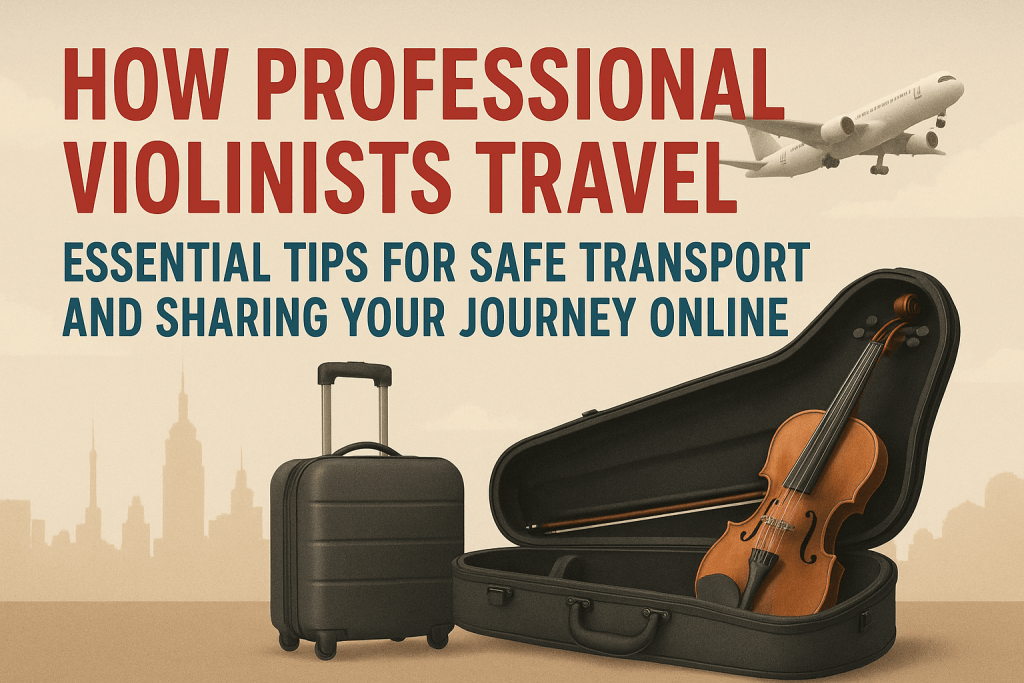Professional violinists are no strangers to life on the road. Whether touring internationally with orchestras, performing at festivals, or attending masterclasses, travel is an integral part of their careers. However, traveling with a delicate instrument like a violin requires careful planning to avoid damage from rough handling, climate changes, or security issues. In this article, we’ll explore proven strategies for how violinists safely transport their instruments, drawing from expert advice and airline policies.
We’ll also touch on how many professionals leverage social media to document their travels, turning journeys into opportunities for audience engagement and growth.

Choosing the Right Case and Preparation
The foundation of safe travel starts with the instrument’s case. Professional violinists typically opt for high-quality, suspension-style hard cases that provide shock absorption and protection against impacts. These cases often feature velvet linings, secure latches, and compartments for bows and accessories. Great Violin Cases recommends avoiding soft gig bags for air travel, as they offer minimal protection.
Before any trip:
- Loosen the strings slightly to reduce tension on the bridge and body.
- Remove any detachable items like shoulder rests or mutes to prevent them from shifting and causing scratches.
- Use a humidifier, such as a Dampit or similar device, inserted into the f-holes to maintain internal humidity levels between 40-60%. This is crucial during flights, where cabin air can be extremely dry and lead to cracking.
For valuable or antique instruments, obtaining specialized insurance is non-negotiable. Policies from companies like Heritage or Clarion cover loss, theft, or damage during transit.
Air Travel: Navigating Airline Policies
Air travel poses the biggest challenges for violinists due to varying airline rules and limited cabin space. U.S. law (under the FAA Modernization and Reform Act of 2012) allows musical instruments as carry-on if they fit in overhead bins or under seats, but enforcement can vary.
Key tips:
- Always carry your violin as hand luggage—never check it in, as baggage handling can be brutal.
- Check specific airline policies in advance. For example, Delta allows violins as a free carry-on if they fit dimensions (typically 22 x 14 x 9 inches). KLM permits instruments up to 55 x 35 x 25 cm as hand baggage.
- If space is an issue, some violinists purchase an extra seat for their instrument, treating it like a “cabin passenger.” This is common for cellos but also viable for violins on long-haul flights.
- Arrive early to board first and secure overhead space. Bring documentation like appraisals or CITES certificates for bows with ivory or endangered materials to clear customs smoothly.
In cases of disputes with gate agents, politely reference airline policies or federal regulations. Many professionals report positive experiences by being courteous and prepared.
Ground Travel: Trains, Cars, and Walking
For shorter trips or tours within a country, violinists often prefer trains or cars for more control over their instrument.
- Trains and Buses: Most rail services (e.g., Amtrak or Eurostar) allow instruments as carry-on without extra fees. Secure the case in overhead racks or dedicated luggage areas, and avoid peak hours to minimize jostling.
- Cars: Use seatbelts to strap the case in place, preferably on the back seat away from direct sunlight. Temperature fluctuations can warp wood, so park in shaded areas and use climate control.
- Walking Long Distances: Shoulder straps on cases make carrying easier, freeing hands for balance. Professionals recommend backpack-style cases for urban tours to distribute weight evenly.
International Considerations
Crossing borders adds layers of complexity. For instruments with restricted materials (e.g., pernambuco bows or tortoise shell), obtain CITES permits well in advance. Always declare your violin at customs to avoid delays, and carry proof of ownership.
Humidity and temperature extremes in different climates require vigilance. Upon arrival, allow the instrument to acclimate gradually before playing music to bop to.
Sharing Your Travels: Building a Social Media Presence On the Road
Beyond logistics, travel offers violinists a chance to connect with fans worldwide. Many professionals document their journeys on platforms like Instagram or TikTok—posting airport rehearsals, scenic practice spots, or behind-the-scenes tour stories. This not only humanizes their craft but also boosts engagement and follower growth.
For instance, sharing tips on packing a violin or overcoming jet lag can resonate with aspiring musicians, turning travels into content gold. To maximize reach, focus on consistent posting, high-quality visuals, and audience interaction.
In summary, traveling as a professional violinist demands preparation, but with the right approach, it can be stress-free and even inspiring. By safeguarding your instrument and embracing digital storytelling, you turn every trip into an opportunity for artistic and personal
